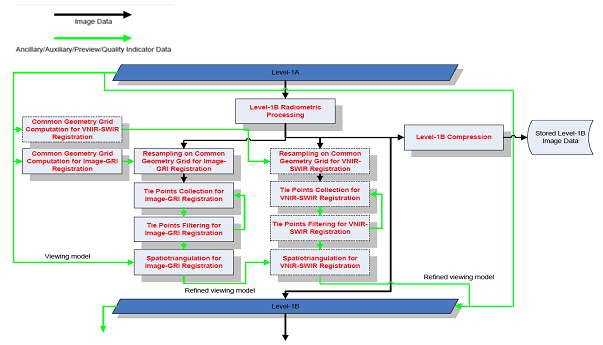The Level-1B User Product (TOA calibrated radiance) is a radio-corrected and geo-refined product obtained from processing and refining the input Level-1A (TOA radiance) data. It includes:
- radiometric corrections
- refinement of the physical geometrical viewing model (which is not applied at this level)

Figure 1: Level-1B Processing Overview
- Level-1B Radiometric Processing includes dark signal correction, pixel response non-uniformity correction, crosstalk correction, defective pixels identification, radiometric offset addition to avoid truncation of negative values and the binning of the 60 m spectral bands. The Level-1B radiometric processing also includes a restoration step (deconvolution plus denoising) for high spatial resolution bands. This correction is disabled by default in the current Level-1B processing.
- Common Geometry Grid Computation for Image-GRI Registration defines the common monolithic geometry in which the Global Reference Images (GRI) and the reference band of the image to refine shall be resampled.
- Resampling on Common Geometry Grid for Image-GRI Registration performs the resampling on the common geometry grid for the registration between the GRI and the reference band.
- Tie-Points Collection for Image-GRI Registration includes the collection of the tie-points from the two images for the registration between the GRI and the reference band.
- Tie-Points Filtering for Image-GRI Registration performs a filtering of the tie-points over several areas (sub-scenes) and a given number of trusted tie-points is required for each subscene.
- Spatiotriangulation for Image-GRI Registration refines the viewing model using the initialized viewing model and the set of Ground Control Points (GCPs) from previous steps. The output refined model ensures the registration between the GRI and the reference band.
- Level-1B Compression compresses Level-1B imagery using the JPEG2000 algorithm. The Kakadu software library is used for the JP2K compression of product images.
Optional Steps in VNIR-SWIR Registration Processing
The following steps are optional and not considered in the current processing:
- Common Geometry Grid Computation for VNIR-SWIR Registration defines the common geometry in which the registration will be performed.
- Resampling on Common Geometry Grid for VNIR-SWIR Registration performs the resampling on the common geometry grid for the registration between VNIR and SWIR bands.
- Tie-Points Collection for VNIR-SWIR Registration includes the collection of the tie-points from the two images for the refinement of the registration between VNIR and SWIR focal planes.
- Tie-Points Filtering for VNIR-SWIR Registration performs a filtering of the tie-points over several areas (sub-scenes) and a given number of trusted tie-points are required for each subscene.
- Spatiotriangulation for VNIR-SWIR Registration refines the viewing model using the initialized viewing model and the set of ground control points from previous steps. The output of this step is a refined viewing model ensuring the registration between VNIR and SWIR focal planes.